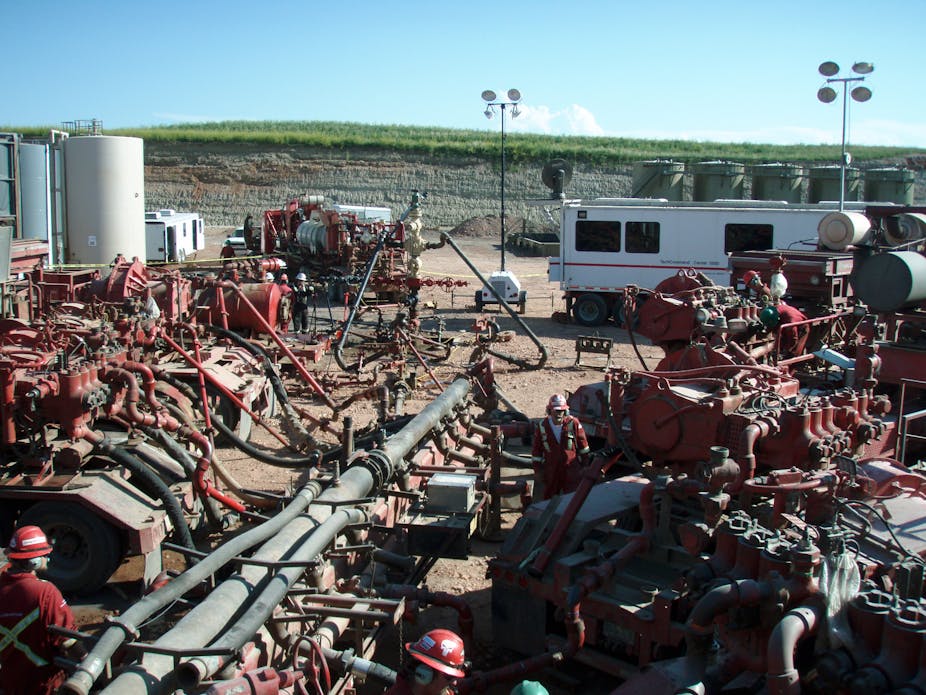An experiment has shed light on how controversial human activities such as fracking can cause small earthquakes. This may enable better controls of hazardous techniques. But it could have even greater relevance as a way to predict big earthquakes and other natural hazards.
The past decade has seen a significant growth in so-called “fluid-injection techniques”. In the most common one – fracking – shale gas is released by the drilling of a high-pressure water mixture into the earth.
The environmental implications of such practices are highly debated. One of the problems is that these injections produce small earthquakes where there is no historical seismic record, meaning we don’t have a good idea about the hazards and vulnerability of these places.

However, the study is a perfect frame for understanding how fault slip works in the presence of fluid flows. This is extremely relevant at large scales, because we know that nature’s own hot fluid injection from the mantle and in subduction processes, when tectonic plates meet, may be a factor in the development of mega-quakes – albeit at a much greater depth. The better we can understand injection, the better the chances that we can one day use it in forecasting quakes.
Quakes: from micro to mega
The experiment looked at fluid injection at a depth of 282 metres in a well-known setting: the cretaceous limestone of the south-east France sedimentary basin. What the scientists did was to activate a natural but inactive fault with a high-pressure injection of water and monitor the consequences with advanced instruments.
The measurements enabled the team to get a complete 3D image of the dynamic of an injected fault in real time, explaining why injection-induced techniques work. They discovered that there was a lack of audible small earthquakes during most of the injection, with a 14-fold increase of “permeability” – the Earth’s ability to allow gas and light fluids to move upward due to deep pressure – before any seismic event occurred. This sets an important time limit to when the injection should stop before causing hazard.
The study is also important to seismologists because the energy that is typically measured from small earthquakes – and used to try to predict bigger ones – is three order of magnitude lower than the effective energy released from the small earthquakes in the experiment. This is because just measuring the energy of the actual quake doesn’t take into account energy released before the eruption from the movement of the fault. Therefore, the “seismic magnitude” technique that we use for predicting hazards from earthquakes strongly underestimates the true energy release of the fault slip, making it an imperfect and late sign of hazard.
The experiment shows that a better alternative for monitoring injection-induced fault slip is “aseismic creeping” – which is the displacement along a fault in the absence of earthquakes – which starts soon after injection. This creeping may be produced by friction of the uneven surfaces along the fault interfaces and is a much earlier symptom of the fault’s movement than small earthquakes.
When there is subduction or rifting, the processes where two tectonic plates meet or separate, creeping results in shallow tremors known as slow earthquakes. These have been recorded just before destructive mega-quakes, as the Tohoku earthquake in Japan, possibly as a consequence of a fluid injection from depth. More recently, along the Kyushu Palau Ridge in the Philippine Sea, this creeping has been detected and monitored, which could be a sign that Japan faces another mega-quake.
These results are a critical advancement for understanding the dynamic of a fault at shallow depths. They can be used by the industry in order to improve methodology and better account for seismic hazard during fracking.
The study shows that creeping can provide us with forecasting information. If scientists can scale up these results to the depths and structures that produce mega-quakes, fluid-injection technology will have granted a value far greater than the economic benefits of fracking.

